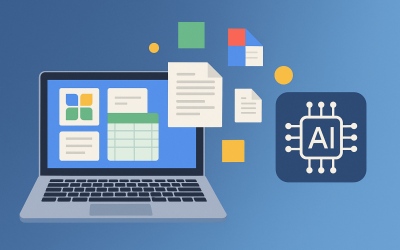Tech That Helps You Do Nothing: Digital Wellness in the Age of AI

In a world obsessed with productivity, “doing nothing” has quietly become the new luxury. We measure our worth in notifications cleared, meetings attended, and steps counted. Yet somehow, despite having more smart devices than ever, we feel less in control of our time.
Enter a new wave of technology built not to push us to do more — but to help us pause, breathe, and reclaim focus. This is the era of digital wellness, powered by AI.
The Paradox: Tech Caused the Problem — and Now It’s Fixing It
It’s a bit ironic, isn’t it? The same phones that distract us now want to heal us. AI is learning when we’re stressed, overworked, or simply overloaded — and stepping in to help us slow down.
From sleep tracking to focus coaching, digital wellness tools in 2025 are shifting from punishment (“Screen time exceeded!”) to partnership (“Hey, you’ve been scrolling a while — want to listen to rain sounds instead?”).
The goal is simple: help you do less, so you can live more.
1. AI That Knows When You’re Overstimulated
Modern smartphones and wearables are now equipped with sensors and AI models that read micro-signals — heart rate spikes, screen-time patterns, voice tone changes.
For example:
-
Apple’s Mindfulness Mode (2025) detects stress from Apple Watch biometrics and dims notifications automatically.
-
Samsung’s One UI Wellness Hub can sense digital fatigue and suggest “quiet mode” breaks.
-
Google’s Digital Wellbeing AI on Pixel devices adjusts app priorities based on your mood and time of day.
They’re not judging you — they’re protecting your attention.
2. The Rise of Calm Tech
“Calm tech” is the design movement behind this shift. The idea? Technology should blend into the background, not demand constant attention.
Instead of glowing screens and dopamine hits, calm tech is:
-
Context-aware (responds to your routine)
-
Low-interruptive (gives you info gently, not urgently)
-
Restorative (helps you recharge, not hustle)
Think of it as anti-FOMO design — minimal notifications, mindful vibrations, and quiet interfaces.
Apps like Oura, Headspace, and Welltory already use AI to personalize downtime routines — guiding users into short micro-breaks before burnout strikes.
3. AI That Helps You Rest, Not Just Sleep
Forget sleep tracking — AI wellness tools now focus on rest quality, not just hours logged.
-
Eight Sleep and Oura use temperature and HRV (heart rate variability) data to optimize your circadian rhythm.
-
Calm’s Sleep Coach now uses generative AI to create custom wind-down routines based on your daily stress level.
-
Spotify’s Soundscape AI curates relaxing sound environments — adaptive playlists that shift as your focus or calmness changes.
The new goal? Make rest proactive, not reactive.
4. Smart Devices That Know When to Leave You Alone
The best tech in 2025 is starting to embrace quiet mode as a virtue.
Your phone knows when you’re driving or in a meeting — but now it also knows when you’re mentally full.
-
Pixel’s Adaptive Notifications: Delays non-urgent alerts when your focus mode is active.
-
iOS Mindful Notifications: Batch low-priority alerts and deliver them after breaks.
-
Nothing OS Zen Mode: Temporarily hides all icons and distractions, encouraging “device rest.”
Even wearables like the Fitbit Sense 3 use AI to learn when you should not be interrupted — like during deep work or emotional dips.
5. Digital Minimalism Meets Automation
Digital wellness isn’t about deleting all your apps — it’s about making your tech work for you automatically.
AI can now automate the “declutter” process:
-
Google Photos AI groups duplicates and auto-archives screenshots.
-
Inbox Zero Assistants summarize and categorize emails, letting you skip inbox chaos.
-
Smart Desktops (Windows Copilot, macOS Siri 2.0) hide rarely used apps during focus periods.
You don’t need to organize — your devices do it for you.
The result? Less screen juggling, more space to think.
6. AI as Your Focus Partner
Apps like Reclaim.ai, Motion, and Notion Calendar use AI to create adaptive focus blocks in your schedule.
They notice when you tend to procrastinate, when meetings pile up, or when your energy dips — and automatically reschedule work blocks or breaks to fit your rhythm.
You can literally say:
“Hey Reclaim, protect my mornings for deep work,”
and it will guard that time like a digital bodyguard.
For students and working pros, this turns chaos into calm — no manual planning, no guilt.
7. Mental Health Without the “App Fatigue”
Not everyone wants to open another app to meditate. That’s where AI micro-interventions come in — tiny, passive interactions built into tools you already use.
-
Google Messages: Now detects emotional tone and suggests calming replies.
-
Microsoft Teams: Offers gentle “mood checks” at the end of workdays.
-
ChatGPT-based journaling bots like Mindsera provide low-pressure mental reflection prompts, right inside your chat apps.
The beauty here? You don’t have to try to be mindful — AI helps you be mindful by default.
8. AI That Encourages Real-World Presence
Digital wellness isn’t just about limiting screen time — it’s about enhancing your real time.
-
AI photo curation tools like Apple Memories now emphasize meaningful moments over volume — showing you less, but better.
-
Ambient AR assistants gently fade notifications when you’re with friends or walking outdoors.
-
Smart rings and earbuds can detect social engagement and lower alerts when you’re in conversation.
The tech is learning a new kind of intelligence — social intelligence.
9. The “Do Nothing” Movement
Minimalism has a new digital twin: the do-nothing movement. It’s about embracing tech that creates white space in your day.
This isn’t about deleting social media or throwing your phone away. It’s about using AI to reclaim time:
-
Time to breathe between meetings.
-
Time to walk without earphones.
-
Time to let your brain wander again.
AI can remind you to rest — and that’s not laziness. That’s balance.
10. The Future of Digital Wellness: Mindful by Design
The next wave of wellness tech won’t need “focus modes” or “wellness apps” at all. Instead, the intelligence will be built into everything:
-
Phones that sense your intent and stay quiet when you’re thinking.
-
Laptops that dim when you look away.
-
Cars that detect stress and adjust lighting and sound automatically.
In other words: tech that senses when to step back.
Final Thought
For years, technology has tried to capture every second of our attention. Now, it’s learning something new — the art of silence.
The best tech of 2025 isn’t about adding more to your life; it’s about giving you more of it back.
So, the next time your phone stays quiet for a few minutes, don’t panic. It might just be helping you do the most productive thing of all — nothing.
















